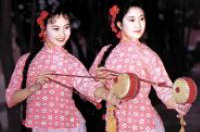
FengyangHuagu(flower drum), also calledHuaguXiaoluoorShuangtiao Gu, is a localQuyigenre in Fengyang County of East China's Anhui Province. It was formed along the Huahe valley in late years of the Ming Dynasty (1368-1644). At that time, Fengyang County was plagued by floods and draughts, and many people went out begging, singingHuagu. Thus,Huagubecame a symbol of begging out of poverty at the first beginning.
Most performers of FengyangHuaguwere female and usually sisters-in-law sang together. During the performance, the two persons sang together while sitting on a bench and beat gongs and drums during interval of two sections without accompaniment of thread or string instruments. Later,ShuangtiaogureplacedHuagu, i.e. the performer holds a small drum in her left hand and beats it with a double-drum arrow in her right hand.Huaguartists brought back many kinds of folk songs and music from other places, and gradually enriched arias of FengyangHuaguand developed several dancing and singing forms based on theHuagutune. FengyangHuagudoes not have long traditional items, its materials are mainly love stories and singing style is relatively flexible. FengyangHuaguis widespread and has certain influence on tunes and performing styles ofQuyiarts in other places.
After China's reform and opening-up in 1979, FengyangHuaguwitnessed many changes in forms and contents. It became a tool of self-entertaining for people in Fengyang County and was more popular in townships. Beating the flower drum, dancing and singing integrated some skills of modern dances and the forms of FengyangHuagubecame more vivacious and diversified. FengyangHuagu became more and more famous and its artists were invited to perform in countries such as Japan several times in recent years and won much recognition there.
